
|
Sale 48
Pre-Long Beach Coin Auction
| World Gold Coins France - Great Britain |
| |
| |
| Lot |
Photo |
Description |
Realized |
Lot 2059 |
 |
Great Britain. Gold Crown of the Double Rose, ND. S.2274; Fr-164. Henry VIII, 1509-1547. Mint mark lis. Obverse: Crowned h and K (Henry and Katherine of Aragon) to each side of central crowned rose. HENRIC VIII RUTILANS ROSA SIE SPIA (SINE SPINA). Reverse Crowned quartered Tudor shield bearing the arms of England and France. Crowned h and K to left and right. A crisply struck coin with sharp detail. Original luster. A remarkably fine example of this (normally) crudely made issue. Struck on a nearly full flan Very rare thus. NGC graded AU-58.
**The royal ciphers on some of his gold crowns and halfcrowns combine the initials of Henry with those of his queens, Katherine of Aragon, Anne Boleyn and Jane Seymour. The King's Chancellor, Cardinal Thomas Wolsy, was responsible for this coinage reform.
Katherine of Aragon was the youngest surviving child of Ferdinand and Isabella of Spain and she was married at the age of 15 to Arthur, the son of England's King Henry VII. Sadly, Arthur died a few months later, and as his father was keen to keep Katherine's dowry, she was betrothed to Arthur's younger brother (the future Henry VIII) who was too young to marry at the time. By the time Henry was old enough to wed, his father had lost interest in a Spanish alliance and forced his son to repudiate the betrothal. Henry VII died in 1509 and the knew king married Katherine in the same year. A son (Prince Henry) was born to the couple in 1511, but he died after 52 days. In 1516 Mary gave birth to a daughter (the future Mary I).
Because Katherine could not produce the son and heir which Henry craved, and because of his great interest in Anne Boleyn, Henry rejected the power of the Pope in England and gave Thomas Cranmer, Archbishop of Canterbury, the task of annulling his marriage to Katherine. This was achieved, Katherine duly left court, and on January 7th 1536 she died.
Estimated Value $6,000 - 7,000.
View details and enlarged photos
| Unsold |
Lot 2060 |
 |
Great Britain. Sovereign, ND. S.2291. Henry VIII, 1509-1544. Third coinage, 1544-7. Mint mark, S. Southwark. King on throne. Reverse Crowned and supported arms. Surfaces have been burnished. Lettering somewhat blundered. A high grade example for this very rare type. Extremely Fine.
Estimated Value $12,000 - 15,000.
View details and enlarged photos
| Unsold |
Lot 2061 |
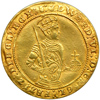 |
Great Britain. Half-Sovereign, ND. S.2451; N-1928; Fr-187. Edward VI, 1547-1553. Tower mint. Third Period. Mint mark Tun. Crowned and armoured half-figure right, holding sword and globus cruciger. Reverse Crowned shield. Surfaces lightly cleaned and buffed. Sharp strike and a pleasing portrait of the young monarch. Extremely Fine.
Estimated Value $7,000 - 8,000.
View details and enlarged photos
| Realized
$7,763 |
Lot 2062 |
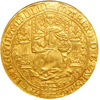 |
Great Britain. 'Fine' Sovereign, of 30 Shillings, ND. S.2488; Fr-192. Mary, 1553-1554. Mint mark, pomegranate. Queen on throne. Reverse Arms on large Tudor rose. The daughter of King Henry VIII who reigned for a brief five years before her premature death in 1558, all Mary's gold coins are rare. This, the largest of the gold coins of the period, is unusually nice for issue. Good portrait and detail. NGC graded AU-55.
Estimated Value $25,000 - 30,000.
View details and enlarged photos
| Unsold |
Lot 2063 |
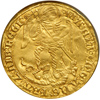 |
Great Britain. Angel, Nd. S.2490; Fr-194. Mary I, 1553-1558. Mint mark pomegranate (1553-54). Annulet stops. Obverse: St. Michael spears dragon. Reverse Old style ship with plain castles bearing shield and cross, M and rose at sides, riding on a sea of small neat waves. Struck on a large round flan. All lettering sharp and design crisp. The portrait is delightful. One of the rarest types of Angel and very difficult to locate in this grade. NGC graded AU-50.
**Mary I elevated the currency by bringing English coinage back to the sterling standard and struck all her gold coins at the traditional fineness of .995. Gold coins of Mary are rare and were only struck in the period 1553-1554. After this, all coins bear the names of Philip (her husband) and Mary. Angels of Mary are seldom encountered in high grade, but this specimen is remarkably well preserved considering the low-relief style of this virtually pure gold issue.
Estimated Value $15,000 - 18,000.
View details and enlarged photos
| Unsold |
Lot 2064 |
 |
Great Britain. Half Pound, Nd. S.2520; Fr-203. Elizabeth I, 1558-1603. Second issue (1560-1). Mint mark, cross crosslet. Obverse: Neat crowned bust of Queen left. ELIZABETH: D.G ANG FRA ET HI REGINA. Three pellets after ELIZABETH. Reverse Crowned square-topped Tudor shield with E R to left and right. Particularly sharp obverse, and excellent detail on shield. This coin has an exceptional portrait and compares well with the specimen in the Millennia Collection. Lightly cleaned. About Uncirculated.
*This coin was produced early in Queen Elizabeth's reign, in the period 1560-1561. Elizabeth has succeeded her sister, Mary I, just two to three years earlier, in 1558. Her first task was to bring about a broad religious settlement and stabilize the nation. As a Protestant who experienced the revulsion felt for Mary and her Catholic entourage at first hand, in 1559 the new Queen took the opportunity to enforce the Protestant religion by law.
Elizabeth was bright, educated and above all a pragmatist. This was just the start of the Elizabethan age - a time of expansion in commerce and geographical exploration when the arts and literature flourished. She was wooed, unsuccessfully, by many European heads of state, and she used these bids to strengthen her power, but she never married. Here began strong links with America, indeed Virginia was named after the 'Virgin Queen'.
Estimated Value $9,000 - 10,000.
View details and enlarged photos
| Unsold |
Lot 2065 |
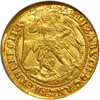 |
Great Britain. Angel, Nd. S.2531; Fr-200. Elizabeth I, 1583-1603. Sixth issue, mint mark Bell (1582-3). Obverse: St. Michael slaying dragon. Reverse Ship to left bearing shield and cross, E and rose at sides. A most handsome coin, well struck on a full flan. Scarcer type and a good mint mark. Very slight original die cracks producing tiny raised lines on the obverse surface add to the distinctive appeal. Lustrous and scarce in this grade. NGC graded MS-62.
* This coin was probably struck in 1583, just five years before the despatch of the Spanish Armada. The arrival in England in 1568 of Mary Queen of Scots and her imprisonment by Elizabeth caused a political crisis, and a rebellion of the feudal nobility of the north followed in 1569. Intense rivalry between English and Spanish sailors hastened the breach with Spain. When the Dutch rebelled against Spanish tyranny Elizabeth secretly encouraged them. Philip II retaliated by aiding Catholic conspiracies against her.
The period 1578-1582 was a time of undeclared war, and exploration of the 'New World'. Later, the landing of an English army in the Netherlands in 1585 and Mary's execution in 1587 brought conflict with Spain into the open. Several years later Philip's Armada (the fleet sent to invade England in 1588) met with total disaster.
Estimated Value $5,000 - 6,000.
View details and enlarged photos
| Unsold |
Lot 2066 |
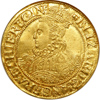 |
Great Britain. Gold Half Pound, ND. S.2535A; Fr-215. Elizabeth I, 1558-1603. Fifth issue. Mint mark, Woolpack (1594-6). Bust of Queen facing left wearing, elaborate dress. Reverse Crowned shield of arms. this very ornate type of Elizabethan half pound is considerably rarer than the plainer style half pound and probably much rarer than the pound piece in the top grades. This specimen is sharply struck with an abundance of original luster. Extremely rare in this grade. NGC graded MS-62.
Estimated Value $20,000 - 25,000.
View details and enlarged photos
| Unsold |
Lot 2067 |
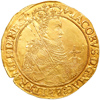 |
Great Britain. Unite, ND. S.2618; Fr-234. James I, 1603-1625. Second coinage (1604-19). Second bust. Mint mark, Lis. Half length figure of King facing right, holding orb and shouldering sceptre. Reverse Crowned shield of arms, I R at sides. Legend FACIAM. Althought lightly cleaned this is a sharply struck example. Extremely Fine.
Estimated Value $2,000 - 2,500.
View details and enlarged photos
| Unsold |
Lot 2068 |
 |
Great Britain. Unite, Nd. S.2618 (incorrect number on holder); Fr-234. James I, 1603-1625. Mint mark rose. Second bust of King, half length, in ornate armour right, holding orb and scepter. Reverse Square crowned garnished shield with I R at sides. The reverse inscription FACIAM EOS IN GENTEM VNAM ('I will make them one nation') refers to the unification of the thrones of Scotland and England when James I (also James VI of Scotland) succeeded Elizabeth I in 1603. This large imposing gold coin was made in the period 1605-1606, the time of the notorious Gunpowder Plot. NGC graded AU-55.
Estimated Value $3,200 - 3,500.
View details and enlarged photos
| Unsold |
Lot 2069 |
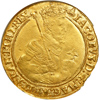 |
Great Britain. Unite, Nd. S.2619; Fr-234. James I, 1603-1625. Fourth bust. Mint mark, bell (1610-11). Obverse: Half length bust of King in armour holding sword and scepter. Reverse Crowned square garnished shield. Nicely lustrous and softly struck, but with no discernible signs of wear. NGC graded AU-50.
Estimated Value $2,700 - 3,000.
View details and enlarged photos
| Unsold |
Lot 2070 |
 |
Great Britain. Angel, Nd. S.2615; Fr-232; North-2081. James I, 1603-1625. Second coinage. Mint mark, tower (1612-3). Obverse: St. Michael spears dragon. IACOBVS D:G: MAG. BRIT. FRA. ET. HI. REX. Reverse Quartered shield over ship. I and rose to left and right. Very rare in this condition, these coins are typically pierced (for suspension) plugged or just low grade. This piece is original with sharp lettering and crisp design. And a scarce mint mark. NGC graded AU-58.
* Gold Angels were struck in this reign from 1605, with a value of ten Shillings. This value was raised in 1612 to eleven shillings, as gold continued to rise in price. The Angel circulated alongside other gold coins such as the Unite and Laurel, which soon eclipsed the Angel in popularity. Consequently, fewer Angel's were produced and the denomination became quite rare.
Estimated Value $8,000 - 9,000.
View details and enlarged photos
| Unsold |
Lot 2071 |
 |
Great Britain. Lion Spur-Ryal of 15 Shillings, ND. S.2634; North-2109; Fr-240. James I, 1603-1625. Third Coinage (1619-1625). Mint mark Spur rowel. Crowned lion facing, supporting arms. Reverse Crowned sunburst, rose at center. Slight flan crinkle as made. Strong detail and much luster. Top grades very difficult to find of this very rare type. NGC graded AU-55.
Estimated Value $30,000 - 40,000.
View details and enlarged photos
| Realized
$31,050 |
Lot 2072 |
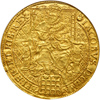 |
Great Britain. Rose Ryal, Nd. S.2632; Fr-239. James I, 1603-1625. Third coinage. Mint mark thistle (1621-3). Obverse: King enthroned holding orb and scepter, back of throne garnished with semee of thistles, portcullis at feet, rich pattern of roses and lis in field, reads MA BRI FR ET HIB. Reverse Shield over cross fleury with XXX (30 Shillings) above, within circle decorated with lis, lions and roses. A wonderfully well struck piece with considerable amounts of original luster. Different type to the (plain throne) variety in the Millennia collection. Excellent round flan. Well detailed. NGC graded AU-55.
Estimated Value $12,500 - 15,000.
View details and enlarged photos
| Unsold |
Lot 2073 |
 |
Great Britain. Laurel (20 Shillings), Nd. S.2638; Fr-242. James I, 1603-1625. Third coinage (1619-25). Second (square headed) bust. Mint mark spur rowel (1619-20). Obverse: Draped laureate bust left. Reverse Crowned quartered shield. Lightly cleaned. Superbly detailed portrait on this scarcer bust variety. Large full flan and well struck up design. Almost Uncirculated to Uncirculated.
Estimated Value $3,500 - 4,000.
View details and enlarged photos
| Realized
$4,830 |
Lot 2074 |
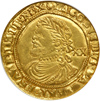 |
Great Britain. Laurel, Nd. S.2638a; Fr-242. James I, 1603-1625. Third coinage. Mint mark thistle (1621-3). Third small rounded head. tie ribbons further apart. Obverse: Laureate armored bust left, vlaue behind. Reverse Long cross over square shield. NGC graded AU-58.
Estimated Value $3,200 - 3,500.
View details and enlarged photos
| Unsold |
Lot 2075 |
 |
Great Britain. Unite, ND. S.2685; Fr-246. Charles I, 1625-1649. Tower mint under the King. Mint mark, Lis. First bust with ruff and collar of order, high double crown. Reads MAG BR FR ET HI. Reverse Crowned square topped garnished shield. Interesting double striking - especially on the reverse of the coin - demonstrating that the coin probably turned in the die. This may explain the irregular shape of the flan and the excess metal to the right of the obverse. A nice color and a good portrait on this Charles I gold coin. Struck in the first year of his reign. NGC graded EF-40.
Estimated Value $2,400 - 2,700.
View details and enlarged photos
| Unsold |
Lot 2076 |
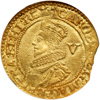 |
Great Britain. Gold Crown, ND. Fr-248; S.2711. Charles I, 1625-1649. Tower mint. Mint mark, Cross Calvary (1625-6). Crowned bust in ruff left. Reverse Square-topped shield. Natural edge clip. Otherwise a well struck and choice little coin. NGC graded MS-63.
Estimated Value $1,200 - 1,500.
View details and enlarged photos
| Unsold |
Lot 2077 |
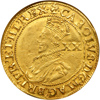 |
Great Britain. Unite, Nd. S.2687; Fr-246. Charles I, 1625-1649. Group B. Mint mark negro's head. Obverse: Second bust, in ruff, armour and mantle, left. Reverse Crowned square topped shield. Very strongly struck in parts though a little soft in others. That is the nature of the gold coins of this era. This is a very scarce and sought after mint mark, which dates the coin at 1626-1627, one of the earliest gold unites struck for this ill-fated monarch. NGC graded AU-55.
Estimated Value $3,700 - 4,000.
View details and enlarged photos
| Unsold |
Lot 2078 |
 |
Great Britain. Pattern Unite, ND. WR-22 (same dies); Allen, NC 1941,vi, same dies; SCBI Brooker 1239, same dies; North-2655. Charles I, 1625-1649. Tower mint. Mint mark, lis. Attributed to A. Vanderdort, probably struck C.1632. Bare headed bust left, in collar and armour of similar style to the gold issues of Group D, no mark of value. Reverse Crowned oval shield with scroll garniture between crowned C - R, struck in high relief. Very Rare. NGC graded AU-55.
Estimated Value $12,500 - 15,000.
View details and enlarged photos
| Realized
$13,225 |
Lot 2079 |
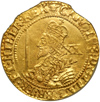 |
Great Britain. Unite, 1643. S.2734; Fr-259. Charles I, 1625-1649. Oxford mint. Obverse: Short wide bust of King facing left, in armour, holding sword and olive branch. Mark of value XX (twenty shillings) behind head. Reads MAG BR FR ET HIBER. Reverse Declaration RELIG: PROT LEG: ANG LIBER: PAR, 1643 on continuous scroll with three plumes above. As with other Civil War issues, this coin has an interesting and irregular shaped flan. Although this is normally a poorly struck issue made during the ravages of England's only Civil War, this coin is remarkably detailed in parts, with good surfaces and much original luster. NGC graded AU-55.
Estimated Value $17,500 - 20,000.
View details and enlarged photos
| Unsold |
Lot 2080 |
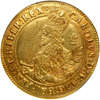 |
Great Britain. Triple-Unite, 1644-OXON. S.2729; Fr-258. Charles I, 1625-1649. Oxford mint. Extremely Rare 'small module' variety. Obverse: Crowned bust of King facing left, holding sword and branch (without scarf) plume in field behind. Reverse Declaration on scroll. RELIG: PROT: LEG: ANG: LIBER: PAR 1644 OXON. This coin is undoubtedly one of the finest examples of this desirable variety and a deep orange tone complements the bold strike on both sides. Carefully produced and well centered, there is no evidence of double-striking and the legends are fully clear. There is an abundance of original luster. NGC graded AU-55.
*It is interesting to note that this, one of the most handsome and important British coins ever produced, was made during an exceedingly turbulent year, as the English Civil War raged. On January 26 1644 Cromwell's Roundheads, the Parliamentary forces, defeated King Charles' Royalists, allowing them to end the six week Siege of Nantwich in Cheshire. Later, on July 2, 1644 the King's army was defeated at the Battle of Marston Moor and Charles effectively lost his hold on the north of England.
The King based himself for some time in Oxford. He was advised not to dissolve the Long Parliament as this would violate the statute of 1641 which said that Parliament could not be dissolved without its own consent. Therefore all members of the Long Parliament were summoned to assemble for a session of Parliament to be held at Christ Church Hall, Oxford. Most of the Members of the House of Lords heeded the summons and came to Oxford, but only about one-third of the House of Commons came. The first session lasted from January 22 1644 to April 16 1644, and the second session lasted October 8 1644 until March 10 1645. The records of the proceedings were carefully burned just before Oxford fell to the Parliamentary forces in 1646.
Finally, after the King had been captured, in January 1649 the House of Commons set up a high court of justice which tried him and condemned him to death. He was executed at the Banqueting House in Whitehall, London a matter of days later.
Estimated Value $85,000 - 100,000.
View details and enlarged photos
| Realized
$80,500 |
Lot 2081 |
 |
Great Britain. Gold Double-Crown, 1651. S.3210; Fr-270. Commonwealth, 1649-1660. Shield of Saint George within wreath. Reverse Shields of Saint George and Ireland; above X, value in Roman numerals. Mint mark, Sun. Beautifully lustrous with a crisp strike and reddish gold toning. Rare in this grade. This type not in the Millennia Collection. NGC graded MS-63.
Estimated Value $7,000 - 9,000.
View details and enlarged photos
| Realized
$18,400 |
Lot 2082 |
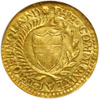 |
Great Britain. Gold Crown, 1652. S.3212; Fr-271. Commonwealth, 1649-1660. Shield of Saint George within wreath. Reverse Shields of Saint George and Ireland; above V, value in Roman numerals. Mint mark, Sun. Beautifully lustrous with a crisp strike and reddish gold toning. Rare in this grade. Seen less often in high grade tha the unites. NGC graded AU-58.
Estimated Value $3,000 - 4,000.
View details and enlarged photos
| Realized
$4,140 |
Lot 2083 |
 |
Great Britain. Unite of 20 Shillings, 1653. S.3208; Fr-269. Commonwealth, 1649-1660. Mint mark, Sun. Obverse: Shield of Saint George within wreath. Reverse Shields of Saint George and Ireland; above, XX, value in Roman numerals. Minor repair in reverse field. Sharply struck with considerable luster remaining. About Uncirculated.
Estimated Value $4,000 - 5,000.
View details and enlarged photos
| Realized
$6,325 |
Lot 2084 |
 |
Great Britain. Gold Broad of Twenty Shillings, 1656. S.3225; Fr-273. Oliver Cromwell, 1653-1660. By Thomas Simon. Obverse: Laureate bust of the Protector left. OLIVAR. D. G. RP. ANG SCO ET HIB & PRO. Reverse Crowned shield of the Protectorate, PAX QVAERTVR BELLO 1656. Edge reeded. Inverted die axis.
This coin has lots of eye appeal, fully prooflike fields, well struck up design, a sharp edge and a pleasingly even old orange tone in the lettering. As was stated in the Millennia Sale catalogue the so-called gold broad, valued in 1656 at 20 shillings, was really the fore runner of the first Guinea, which was introduced in the following decade and also valued at twenty shillings. After the death of Cromwell and the restoration of the monarchy in 1660 these coins were often melted or defaced. Wilson and Rasmussen classify the Cromwell Broad as 'Rarity 2' (Very Rare), but high quality examples such as this, are extremely rare. NGC graded MS-61.
** Oliver Cromwell entered Parliament as a member in 1629 and became active in events leading to England's Civil War. He organized the New Model Army which he led (with General Fairfax) to victory at Naseby in 1646, and he declared Britain a Republic ('the Commonwealth') in 1649 following the execution of King Charles I.
A tough and purposeful character, Cromwell established religious tolerance and raised Britain's prestige in Europe. But in 1649 he executed the leaders of the Levellers (who demanded radical reforms) and used terror to crush the Irish clan leaders (1649-1650) and the Scots who had acknowledged Charles II as King, 1650-1651. He ruled with great tenacity and his last parliament offered him the crown, which he refused. In 1658 Cromwell was struck by a form of malarial fever, followed swiftly by a severe urinary infection. His health deteriorated and he died in London on 3 September 1658. Desiring change, the people welcomed back the monarchy in the form of a chastened King Charles II in 1660.
Estimated Value $22,500 - 27,500.
View details and enlarged photos
| Unsold |
Lot 2085 |
 |
Great Britain. Guinea, 1668. S. 3342; Fr-287. Charles II, 1660-1685. Third laureate bust right, pointed truncation. Reverse Crowned cruciform shields. A handsome coin with a pleasing orange-tined mint bloom. No weakness. All Charles II Guineas of the 1660's are rare and this is a tough date to find in high grade. Significantly it was missing from both the Terner and Millennia collections. NGC graded AU-55.
Estimated Value $6,500 - 7,500.
View details and enlarged photos
| Unsold |
Lot 2086 |
 |
Great Britain. Two Guinea, 1676. S.3335; Fr-284; KM-443.1. Charles II. Second laureate bust right, with rounded truncation. CAROLVS.II.DEI.GRATIA. Reverse Inverted die axis crowned cruciform shields. Interlinked C's in center, date at top. MAG.BR.ET.HIB.REX. Edge obliquely grained. This is an exceptional coin - fully struck up, no weakness and with attractive red tone and full underlying luster. Although this is not a specimen striking it is all the more remarkable as a currency piece which has escaped the problems of poor production normally associated with circulation gold coins of this period. NGC graded AU-58.
Estimated Value $15,000 - 18,000.
View details and enlarged photos
| Unsold |
Lot 2087 |
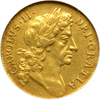 |
Great Britain. Half Guinea, 1679. S.3348; Fr-290; KM-439.1. Charles II. Second laureate bust right. Probably rarer than the Guinea, this is good quality specimen. NGC graded AU-50.
Estimated Value $2,700 - 3,000.
View details and enlarged photos
| Unsold |
Lot 2088 |
 |
Great Britain. Five Guineas, 1688. S.3397; Fr-292. James II, 1685-1688. First laureate bust facing left. IACOBVS II DEI GRATIA. Reverse Crowned cruciform shields, scepters in angles. Edge reads +DECVS.ET.TVTAMEN.ANNO.REGNI.TERTIO+ in raised letters. Sharply struck on a good flan with exquisite detail. Strong mint bloom and an absence of striking weakness, blank filing, adjustment marks, metal specks and other problems which plague the gold coinage of this short reign! One of the finest known examples of this rare first bust type Five Guineas. NGC graded MS-61.
* The reign of James II was brief, and the coinage spanned a mere three years. Consequently, James II coins are among the scarcest and most avidly collected in the British numismatic series.
James, the brother of Charles II, was born in October 1633 and married Anne Hyde, with whom he had eight children. In many ways he lived in the shadow of his brother, but, after the death of Charles, James soon showed that he had little tact or intuition. His reign was doomed after the loyalist Tories moved against him over his many Catholic appointments, and Parliament invited his son-in-law and daughter (William and Mary) to become joint monarchs. After abdicating James settled in France and died in exile.
Estimated Value $24,000 - 28,000.
View details and enlarged photos
| Realized
$25,300 |
Lot 2089 |
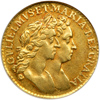 |
Great Britain. Half Guinea, 1689. S.3429; Fr-306; KM-473. William and Mary, 1688-1694. First conjoined busts right. GVLIELMVS ET MARIA DEI GRATIA. Reverse First crowned shield of arms. A delightful red tone and a crisp strike distinguish this otherwise crudely made issue. A very are one-year type coin. NGC graded AU-55.
Estimated Value $5,000 - 6,000.
View details and enlarged photos
| Unsold |
Lot 2090 |
 |
Great Britain. Guinea, 1700. S.3460; Fr-313; KM-498.1. William III, 1694-1702. Second laureate bust right. GVLIELMVS III DEI GRA. Reverse Crowned cruciform shields, human-headed harp in Irish arms. This piece is sharply struck with full original brilliance. NGC graded MS-62.
Estimated Value $8,000 - 9,000.
View details and enlarged photos
| Unsold |
Lot 2091 |
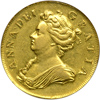 |
Great Britain. Five Guineas, 1705. S.3560; Fr-317; KM-520.2. Anne, 1701-1714. First draped bust left, ANNA. DEI. GRATIA., toothed border. Reverse Pre-Union cruciform crowned shields, semi-frosted inner rings to small crowns, rose in center, scepters in angles. Edge inscription in raised letters +DECVS.ET.TVTAMEN.ANNO.REGNI.QVINT. Struck on good broad flan with lots of original color and with great eye appeal. Comparatively blemish free, this is a wonderful example of the scarce second date in this short (seven year) series. NGC graded AU-55.
Estimated Value $14,000 - 17,000.
View details and enlarged photos
| Realized
$13,225 |
Lot 2092 |
 |
Great Britain. Half Guinea, 1710. S.3575; Fr-323; KM-527. Queen Anne. Draped bust of Queen left. Reverse Crowned cruciform shields. A boldly struck coin with prooflike surfaces and sharp frosty design. NGC graded MS-62.
Estimated Value $3,800 - 4,200.
View details and enlarged photos
| Realized
$4,370 |
Lot 2093 |
 |
Great Britain. Two Guineas, 1711. S.3569; Fr-319. Queen Anne. Draped bust of Queen left. Reverse Crowned cruciform post-union shields. Edge obliquely grained. A very minor obverse scratch. A sharply struck and lustrous coin with great eye appeal. About Uncirculated.
Estimated Value $11,000 - 13,000.
View details and enlarged photos
| Unsold |
Lot 2094 |
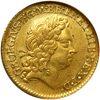 |
Great Britain. Half Guinea, 1718. S.3635; Fr-329; KM-541.1. George I, 1714-1727. First laureate head of King right. Reverse Crowned cruciform shields, scepters in angles. A lovely blemish free example of this scarcer early type half guinea. NGC graded AU-58.
Estimated Value $2,200 - 2,400.
View details and enlarged photos
| Realized
$2,220 |
Lot 2095 |
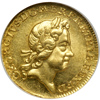 |
Great Britain. Quarter Guinea, 1718. S.3638; Fr-331; KM-555. George I. Laureate head right. Reverse Crowned cruciform shields. Edge obliquely grained. A fantastic example of what is probably the smallest British gold coin. Rarely ever seen in such high grade. NGC graded MS-65.
Estimated Value $1,250 - 1,500.
View details and enlarged photos
| Realized
$2,070 |
Lot 2096 |
 |
Great Britain. Half Guinea, 1725. S.3637; Fr-329; KM-560. George I, 1714-1727. Second laureate head right. Reverse Crowned cruciform shields incorporating the arms of Hanover. A brilliant specimen, on a large flan. Sharply struck with full detail and original luster. NGC graded MS-64.
Estimated Value $3,500 - 3,800.
View details and enlarged photos
| Realized
$4,485 |
Lot 2097 |
 |
Great Britain. Two Guineas, 1735. S.3667A; Fr-336a. George II, 1727-1760. Young laureate bust of King. Reverse Crown with pointed arches over Hanoverian shield of arms. This is one of the rarer and more sought after dates in the short George II Two Guinea series. A handsome coin with crisp, problem-free detail and a sharp (obliquely reeded) edge. Lightly cleaned, plenty of luster remaining. About Uncirculated.
Estimated Value $4,000 - 4,500.
View details and enlarged photos
| Realized
$3,795 |
Lot 2098 |
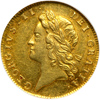 |
Great Britain. Half Guinea, 1736. S. 3681A; Fr-345. George II. Young laureate bust of king left. Reverse Modified crowned garnished shield. An impressive coin with deep golden toning in the lettering and a very strong portrait. The early half guineas of George II are seldom seen in this superb state of preservation. NGC graded AU-58.
Estimated Value $3,000 - 3,500.
View details and enlarged photos
| Unsold |
Lot 2099 |
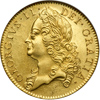 |
Great Britain. Five Guineas, 1748. S.3666; Fr-334. George II. Old laureate bust left. Legend reads GEORGIVS.II.DEI.GRATIA. Reverse Crowned quartered shield of arms. Edge inscription in raised letters DECVS.ET.TVTAMEN.ANNO.REGNI.VICESIMO.SECVNDO. It is rare to find a George II Five Guineas which has seen no circulation. This specimen radiates original mint luster and has a great prooflike quality, all detail is sharply defined. A rare coin in any grade, this is an exceptional example. Catalogue value £9500 ($19,000) in XF, it is unpriced in higher grades. NGC graded MS-62.
Estimated Value $22,500 - 25,000.
View details and enlarged photos
| Realized
$29,900 |
Lot 2100 |
 |
Great Britain. Guinea, 1759. S.3680; Fr-344; KM-588. George II. Old laureate head left. Reverse Crowned quartered shield of arms. Edge curve grained. Nice sharp portrait and crisp design distinguish this early Guinea. NGC graded MS-62.
Estimated Value $4,000 - 5,000.
View details and enlarged photos
| Realized
$4,025 |
Lot 2101 |
 |
Great Britain. Half Guinea, 1759. S.3685; Fr-349; KM-587. George II, 1727-1760. Old laureate bust of king facing left. Reverse Garnished crowned shield. Crisp frosty surfaces which are typical of the finest specimens of the end-of-reign George II half guinea. A well struck uncirculated coin. NGC graded MS-63.
Estimated Value $2,500 - 2,800.
View details and enlarged photos
| Realized
$2,760 |
Lot 2102 |
 |
Great Britain. Quarter Guinea, 1762. S.3741; Fr-368. George III. Long haired laureate bust, right. Reverse Crowned quartered shield of arms. Exceptionally high grade for this small gold piece. NGC graded MS-64.
Estimated Value $1,250 - 1,500.
View details and enlarged photos
| Realized
$1,150 |
Lot 2103 |
 |
Great Britain. Half Guinea, 1775. S.3734; Fr-361; KM-605. George III. Fourth laureate head right. Reverse Crowned shield of arms. A difficult date to obtain in any grade above very fine. NGC graded MS-62.
Estimated Value $1,100 - 1,300.
View details and enlarged photos
| Realized
$1,121 |
Lot 2104 |
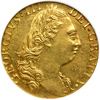 |
Great Britain. Guinea, 1776. S.3728; Fr-355; KM-604. George III. Obverse: Fourth laureate head right, GEORGIVS III DEI. GRATIA. Reverse Inverted die axis. Crowned quartered shield of arms. Six hearts in Hanoverian arms. Edge curved grained. A good and high grade example of this popular date. Who knows if this British gold coin was struck around the time of July 4th 1776 when the United States officially declared independence from the British Empire?! NGC graded MS-62.
Estimated Value $1,750 - 2,000.
View details and enlarged photos
| Realized
$2,415 |
Lot 2105 |
 |
Great Britain. Guinea, 1779. S.3728; Fr-355; KM-604. George III. Fourth laureate head right, GEORGIVS III DEI GRATIA. Reverse Crowned quartered shield of arms. A very tough date to obtain in high grade. A deceptively rare date, absent from the Terner and Millennia collections. NGC graded MS-62.
Estimated Value $1,800 - 2,200.
View details and enlarged photos
| Realized
$1,725 |
Lot 2106 |
 |
Great Britain. Half Guinea, 1779. S.3734; Fr-361; KM-605. George III. Fourth laureate head right. Reverse Crowned shield of arms. A very crisp example of this rarer date. Lots of frosty mint luster. The only other top quality specimen offered in recent years was the Dr. Terner piece. NGC graded MS-63.
Estimated Value $1,600 - 1,800.
View details and enlarged photos
| Realized
$1,840 |
Lot 2107 |
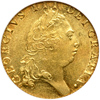 |
Great Britain. Guinea, 1793. S.3729; Fr-356; KM-609. George III. Fifth laureate head right. GEORGIVS.III.DEI.GRATIA. Reverse Crowned quartered spade shaped shield of arms. Very attractive. NGC graded AU-58.
Estimated Value $1,200 - 1,400.
View details and enlarged photos
| Realized
$1,380 |
Lot 2108 |
 |
Great Britain. Spade Guinea, 1796. S.3729; Fr-356; KM-609. George III. Fifth laureate head right. Reverse Crowned quartered spade shaped shield of arms. A light orange tone distinguisheds this rare date Guinea. Another scarce piece which was not represented in the Jacob Terner Collection or the Millennia Collection. NGC graded MS-62.
Estimated Value $1,800 - 2,000.
View details and enlarged photos
| Realized
$1,783 |
|
|